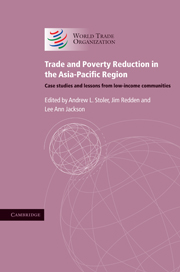 Trade and Poverty Reduction in the Asia-Pacific Region
Trade and Poverty Reduction in the Asia-Pacific Region Book contents
- Frontmatter
- CONTENTS
- CONTRIBUTORS
- ACKNOWLEDGEMENTS
- ABBREVIATIONS
- Introduction
- The economic effects of trade on poverty reduction: perspectives from the economic literature
- I Transnational corporations, trade and poverty reduction
- II Trade in agriculture and poverty reduction
- III Trade in services and poverty reduction
- IV Migration, labour mobility and poverty reduction
- 4 Migration, labour mobility and poverty
- V Trade and poverty reduction in small and vulnerable economies
- INDEX
- References
4 - Migration, labour mobility and poverty
Published online by Cambridge University Press: 05 March 2012
- Frontmatter
- CONTENTS
- CONTRIBUTORS
- ACKNOWLEDGEMENTS
- ABBREVIATIONS
- Introduction
- The economic effects of trade on poverty reduction: perspectives from the economic literature
- I Transnational corporations, trade and poverty reduction
- II Trade in agriculture and poverty reduction
- III Trade in services and poverty reduction
- IV Migration, labour mobility and poverty reduction
- 4 Migration, labour mobility and poverty
- V Trade and poverty reduction in small and vulnerable economies
- INDEX
- References
Summary
Introduction
Migration has always had both beneficial and negative impacts on migrants themselves, their origin communities and their destinations. However, recently, a higher level of attention has been focused on this issue, for a number of reasons:
The last two decades have seen an increase in the scale and complexity of international migration.
The dominant gradient of flow has moved from north–north to south–north countries so that the potential developmental effects on south countries have increased.
Not only have the numbers of expatriates from poorer countries in better-off nations increased exponentially, but the ‘hyper-connectivity’ (Dade, 2004) facilitated by modern information, communication and travel technology has allowed these expatriates to maintain stronger and more intimate linkages with their home countries than ever before.
A shift in the global discourse around the developmental impacts of international migration away from a dominant focus on ‘brain drain’ toward one which recognises that the movement also has positive impacts on origin communities.
Accordingly, there has been enhanced interest not only in the relationship between migration and development but especially in the possibility of developing policies and programmes that can enhance the positive effects on origin nations but also ameliorate the negative impacts. Accordingly, multilateral agencies such as the World Bank (World Bank, 2006; Ellerman, 2003, Terry and Wilson, 2005), the UN (2006a) and Asian Development Bank (ADB) (2004), as well as national development assistance agencies such as DFID (DFID, 2007; House of Commons, 2004) and USAID (Johnson and Sedacca, 2004), are now examining the potential for intervention, which will enhance international migration's contribution to economic and social development and poverty alleviation in poor countries.
- Type
- Chapter
- Information
- Trade and Poverty Reduction in the Asia-Pacific RegionCase Studies and Lessons from Low-income Communities, pp. 465 - 592Publisher: Cambridge University PressPrint publication year: 2009
References
- 1
- Cited by
